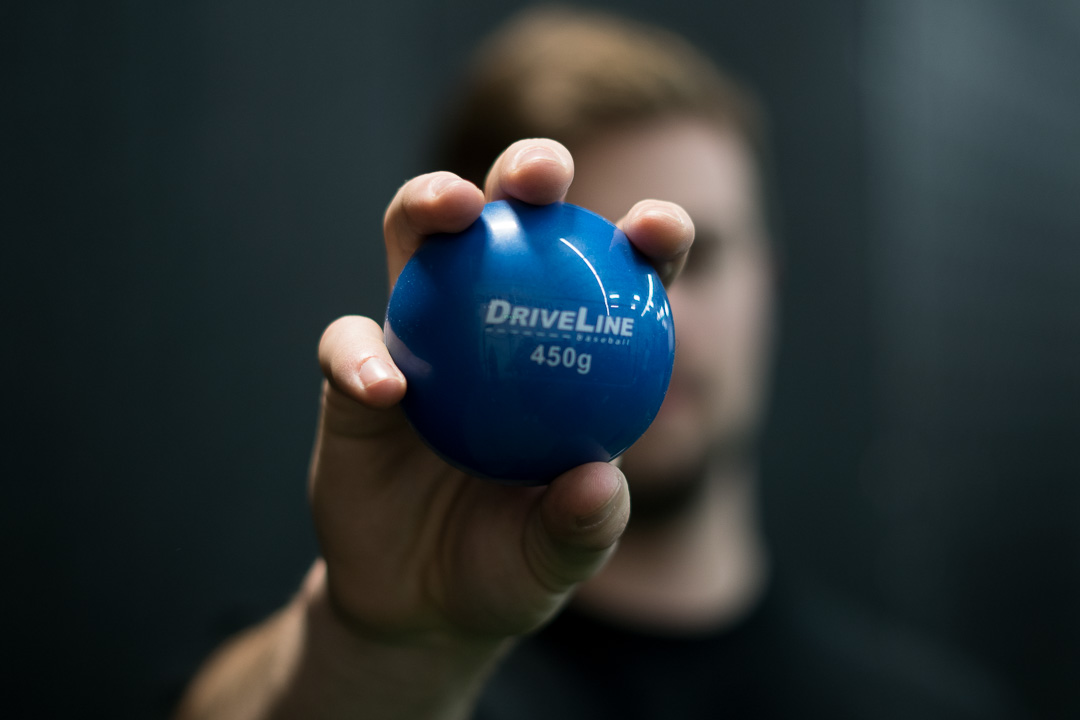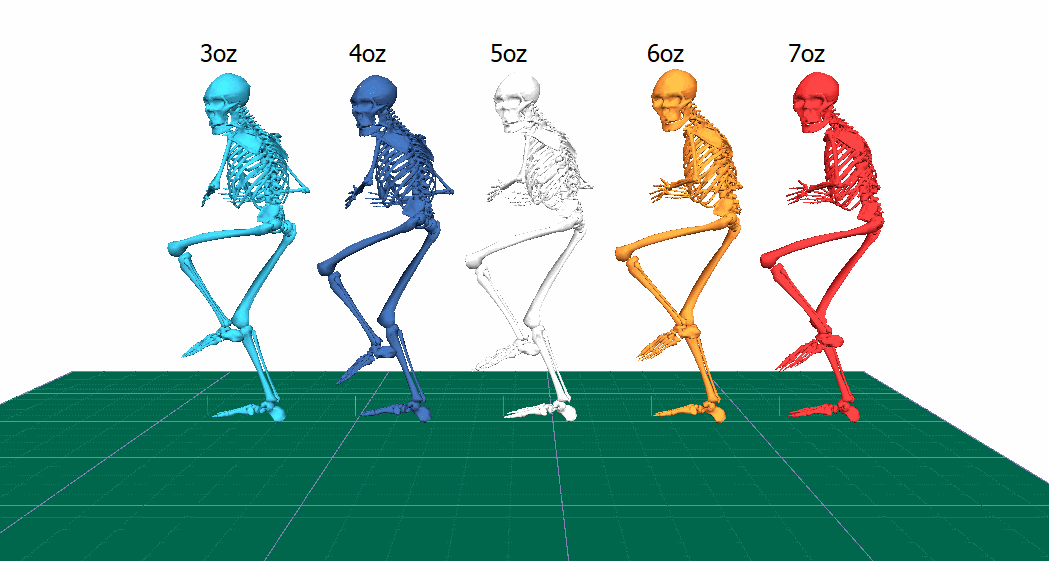Weighted Ball Training: Recreating and Validating 3-7oz Ball Research

Weighted ball training has grown in popularity in recent years, but although there have been numerous papers on the effectiveness of weighted balls, there is still some debate as to how exactly they work to improve velocity.
As we’ve said previously, we didn’t think weighted balls worked until we tried them. Of course, there are a number of variables to account for in a player’s training, and as for weighted balls themselves, research has been heavy on programming investigations and light on specific biomechanical changes.
Soviet Sports Science’s research on over/underweight implements hypothesized that changing weights worked on the ‘speed-strength’ spectrum, with some suggesting that athletes should only adjust the weights within 20% overload or underload of the competition weight.
The closest we’re going to get to figuring out ‘how weighted balls work’ is going to be by looking at the acute biomechanical changes and pairing that with studies on specific programming.
As training becomes increasingly holistic, it’s important to note how difficult it is to identify what aspects of training may have caused a given result. Weighted balls, Plyo Ball ®, cues, drills, mobility work, strength work and programming are all factors in a player’s development, good or bad. After all, studies that look at specific programming with weighted balls are studies of both the types of weighted balls used and the programming: sets, reps, and intensity of the throws. Making their results only true to that specific programming and not relevant to other studies with other sets, reps, and intensities.
ASMI looked at 4-7 oz balls in pulldowns and off the mound and found that the heavier balls (6 & 7 oz balls) produced less torque than a standard baseball. We’ve talked about the results of that study many times previously, but since the pitchers in that study didn’t throw 3 oz baseballs, we wanted to recreate the study with 3 to 7 oz baseballs thrown only off a mound.
Going into the study, our hypothesis was that we’d find similar results to ASMI.
“…we hypothesized that varying the pitched ball weight between three, four, five, six, and seven ounces would significantly affect pitched ball velocity, upper body kinematics, lower body kinematics, kinematic velocities, and throwing arm joint kinetics during a maximum intent throwing workout.”
We had 26 athletes throw in the study. They were acclimated to weighted ball training, so it is possible that results would be different in athletes who are new to training. We also had athletes throw the ball weights in the progression that we programmed for mound work or pulldown days: 5 oz, 6 oz, 7 oz, 5 oz, 4 oz, 3 oz.
Because we had them throw weighted balls in a specific progression and not random, we consider the results of our study to be specific to this sequence of weighted balls and not all weighted ball throwing. Lastly, in another difference from ASMI our throws only took place on the mound, no running throws.
What We Found
Unsurprisingly, we found fairly similar results to ASMI, with only a few differences. Peak rotational speeds decreased, torso forward tilt increased, and pitch velocity decreased as ball weight increased from 3 ounces to 7 ounces.
There are two important things to note. First, below are the discrete metrics that we tested; think snapshots in specific moments of time. We’ll look at the full signal analysis in a separate blog. Second, the threshold we used for significance was strict to account for the number of comparisons that we made. Below are what we found significant, along with a few key metrics we didn’t find significant:
- Heavier balls led to lower maximum elbow flexion (2 degrees of difference)
- We found no significant difference in maximum external rotation
- Heavier balls led to more forward trunk tilt at ball release (the biggest difference was 2 degrees between 3 and 7 oz balls), with the chest more parallel to the ground.
- Heavier balls led to lower peak pelvis ang. velo (~30 deg/second diff between 3 and 7 oz)
- Heavier balls led to lower peak shoulder internal rotation velo (~230 deg/second diff between 3 and 7 oz)
- Heavier balls led to lower peak elbow extension velo (~120 deg/second diff between 3 and 7 oz)
- Velo was significantly affected by ball weight, obviously:
- 3 oz mean velo: 90.3 ± 4.11
- 4 oz mean velo: 87.1 ± 3.82
- 5 oz mean velo: 86.2 ± 3.73
- 6 oz mean velo: 83.1 ± 3.77
- 7 oz mean velo: 80.2 ± 3.6
- We found no significant differences between elbow or shoulder torque

So, pitchers are more anteriorly tilted at ball release, have lower peak elbow flexion, have a slower pelvis, and slower arm with heavy balls and vice versa. They also throw slower with heavy balls. There was no significant effect on the elbow or shoulder kinetics we tested.
These were the relationships where we found significant differences. We’ll take deeper dives into what we think they mean below.
As a quick reminder, here are some definitions:
Kinematics: Motion of objects without reference to the forces that cause it
Example: Arm speed or other rotational velocities
Kinetics: The study of forces acting on a mechanism
Example: The torque on the elbow or shoulder
Arm Kinematics
Heavier balls led to lower maximum elbow flexion between the 3 & 6 oz ball, 4 & 6 oz ball and 4 & 7 oz ball. As we said previously the size of these differences was very small: 2 degrees.
We found no significant difference in maximum external rotation. Although it has been hypothesised that throwing heavier balls increases external rotation when throwing, we found no evidence of this when analyzing the group as a whole with 6 & 7 oz balls.
Mid-Section Kinematics
Heavier balls led to more forward trunk tilt at ball release, with the biggest difference being 2 degrees between 3 and 7 oz balls, though we saw a significant difference between the 3 & 4 oz baseballs and all other conditions. That said, it’s important to repeat that the size of these changes was also very small, with the biggest difference being 2 degrees.
Heavier balls led to lower peak pelvis angular velo. The most significant difference was the ~30 deg/second difference between the 3 and 7 oz balls, while there were also significant differences between the 3 & 6 oz and 4 & 7 oz balls. The pelvis rotated faster in the underload condition.
Similar to previous findings by ASMI, these results suggest that changing the ball weight can change kinematics outside the arm.
Underload balls seem to result in a slightly faster pelvis and slightly forward trunk at ball release. It’s important to note that even though these differences were found, they are likely small enough to not have a significant effect on training decisions. More research looking at targeted throwing of underload balls to change those conditions would be needed.
Kinematic Velocity
A somewhat interesting finding was significant differences between all ball velocities, with velocities decreasing as ball weight increased. However, not every ball weight resulted in significant differences in internal rotation or elbow extension.
For internal rotation, the 7 oz produced significantly lower arm speed than the 3, 4 and 5 oz balls. The 3 oz had significantly higher arm speed than the 6 oz and 5 oz. For elbow extension, the 3 oz was significantly different than the 6 and 7 oz balls.
These results do differ from ASMI’s findings, which found significant differences between all ball weights, and differences between 4-7 oz balls in shoulder internal rotation and elbow extension.
One reason this may have occurred is that ASMI had players throw weighted balls in a random order, where our athletes threw in a progression. This means that fatigue could have been a factor when throwing the underload balls in our study with the underload balls being thrown last.
It’s also possible that single point analysis of peak arm speeds is incomplete, and that there would be differences in full signal analysis or small differences in timing between the peaks.
Kinetics
Another surprising difference between our findings and ASMI was that we didn’t see a significant difference in torque between ball weights. This was a key finding of ASMI’s paper that we discussed previously, with torques decreasing as the ball weight increased.
Our theories for why we had these differences come down to the previously mentioned difference in sequencing of the ball weights thrown and fatigue, though there is the possibility that there may be a training effect depending on how experienced someone is in throwing weighted balls.
What does this tell us about pitching mechanics and weighted balls?
Overall, these results support the thesis that throwing weighted balls from 3 to 7 ounces results in few significant differences in pitching mechanics. The significant differences we did find are very small in size. Supporting the thesis that athletes may throw 3 to 7 oz balls and stay relatively ‘within’ their mechanics.
If we look at our findings and specific differences between the competition weight of 5 oz and the 3, 4, 6, and 7 oz baseballs, we only found three: a difference in elbow extension between the 3 and the 5 oz, and difference in forward trunk tilt between the 3 & 5 oz and 4 & 5 oz.
Put another way, when looking at 4, 5, and 6 oz baseballs, we found one significant difference between the 4 & 6 oz baseball in elbow flexion (of less than 2 degrees) and differences in forward trunk tilt between the 4 & 6 and 4 & 5 oz. This supports the previously mentioned thesis that training within 20% of competition weight can train an athlete on the speed-strength spectrum while staying within their own mechanics.
More changes were seen between the different weighted balls and not between the competition weight and weighted balls.
These findings and ASMI’s comments that the effects they found were relatively small fully support the thesis that pitchers can train with implements within 20% of competition weight and see nearly no change in their mechanics. Further, changes outside of that 20% threshold still see relatively small differences. For reference 4 & 6 oz balls are 20% lower and higher than a 5 oz competition weight. 3 & 7 oz balls are 40% from competition weight.
We can then think of training at high intent with weighted balls as a speed/strength tool that is relatively agnostic to changes in pitching mechanics. So, we can separate work to make specific changes in mechanics from work with Plyo Ball ®, constraint drills and cues. Plyo Ball ® are heavier and the drills we use them in are intended to make mechanical changes. But that can be paired with more specific velocity work with weighted balls (3-7 oz) that may have a complementary effect on velocity while having a much smaller effect on pitching mechanics.
Of course, these statements are relative to each player’s starting point and the specific programming that is assigned to them. We also have some unanswered questions regarding changes in arm speed and its relationship to changes in velocity. This goes to show that there are still plenty of biomechanics-related questions that remain unanswered, which we hope to address in the following years.
Comment section
Add a Comment
You must be logged in to post a comment.
phil_apa -
Good article. Are there any weighted ball studies that go beyond the 7oz ball (some weighted ball sets go as high as 12oz)? Personally, I have gone up to 9oz with my players and have seen increases in velocity, but these are purely anecdotal. Thanks